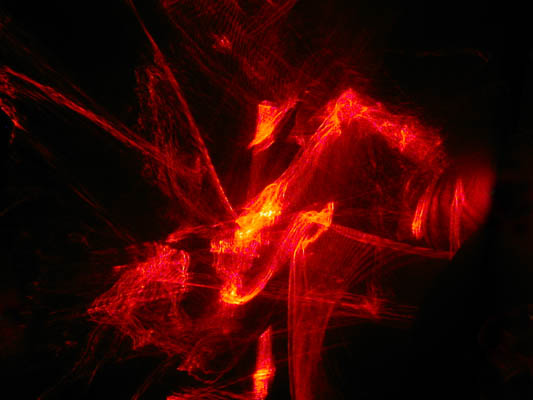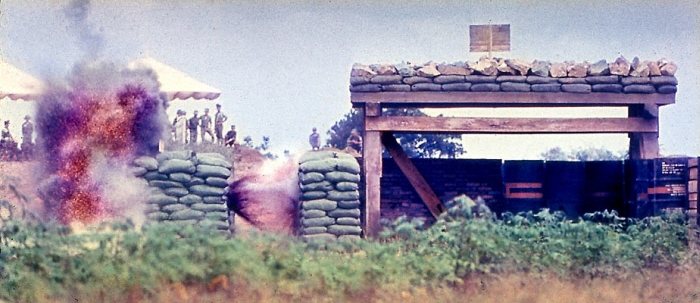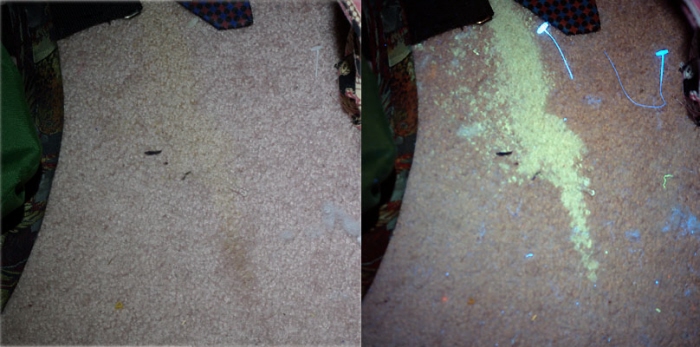
Motion analysis - Lasers mounted to what seems to be a highly stable object can reveal minute movements. Long distance photos of a laser target enlarge even the smallest movements which can then be quantified through trigonometry.

Birdstrike - latent print - This is the latent image produced by dust and body oils when a bird struck a plate glass window. The bird is gone, this is just the body print left on the glass. An animal was hurt in the production of this picture, but he flew into the glass on his own and we are glad to report that he also flew away on his own.

Weapons testing - This photo provides evidence of both the protection and lack of protection offered by sandbagged bunkers. This particular weapon is a rocket propelled grenade. The sandbags do absorb the blast effects and fragmentation however the rocket motor did penetrate both sandbag walls and the dirt filled drum on the far side of the bunker.

Ultraviolet Forensics - Left: What the naked eye sees.
Right: Ultraviolet reveals splash of animal urine, clothing tag connectors, and tufts of soft toy filler, and unidentified fibers.

Motion Study - hand held - This is a handheld photo of a laser dot at 39' from the camera location with a half second exposure. The camera wanders about one inch. The photographer was an Army trained marksman using the BRASS technique (breath, relax, aim, slack, squeeze).

Motion study - monopod with foot brace - Compare this image shot with a monopod and anti-rotation foot brace to tripod mounted and hand-held photos. Alternating black marks are 1" long.
Photo copyright Roger Hawkins 2009

Tripod mounted camera - laser dot target - With a tripod mounted camera the laser dot image is so steady that you can see concentric rings of light from reflections produced by the machining inside the laser barrel.

Infrared VS Visible light - Right: The steel cellphone tower blends with the color of the live foliage.
Left: In the b&w photo taken in a narrow band of the infrared spectrum there is no doubt what is live and what is not.
If the cell phone tower were in a palm grove it would be even harder to see.
Archeologists are finding lost cities in the middle of dense jungle using multispectral scanning which highlights the difference between healthy jungle and jungle growing over stone ruins.
copyright Roger Hawkins 2009

Near infrared camouflage busting - The foreground palm is live while the background palm (cell phone tower) is made of steel painted to match the foreground palm. On closer inspection, the trunk of the background palm shows stripes and blotches not visible to the human eye. The infrared sensitivity is seeing through the surface paint showing welds and rust in the steel trunk.
Photo Copyright Roger Hawkins 2009

Material differentiation - The old sock and the stuffed toy share similar coloration in normal light, but in soft lighting the whiskers are almost invisible. Under ultraviolet (UV) the sock is clearly a different material and the invisible whiskers pop right out. So multi-spectral lighting plays a role in both analysis and discovery.

Pseudo rollout photography - The object above is a closeup of a cannon. Twelve photos were taken 30 degrees apart and the resulting images stitched together into one long strip that you see at the bottom of the photo. It is like taking a cigar band, opening it and pressing the band flat. Archeologists do this with pots to study the narrative shown in decorative artwork. Forensic scientists might use it to study tool marks. See the next photo to see another way of using this technique.
Copyright Roger Hawkins 2009

Virtual models of physical objects - This is a virtual (computerized) model of a 3D object (in this case a small segment of a cannon). Note how the decorative band from the previous photo has been stripped off the real object, flattened, and then reapplied in 3D to a computer model that can be viewed and manipulated in three dimensions.
model copyright Roger Hawkins 2009

Spatial analysis models - Any object can be modeled in 3D so that juries, police, planning commissions, legislators etc. can understand, investigate, and plan with a fuller comprehensions of sizes, distances, spatial relationships etc. These virtual 3D models are made with a combination of 3D drafting, photography, and manual data collection.

Focus stacking - The closer you get to an object the less likely the entire object will be in focus. Large view cameras can tilt the lens toward the plane you want in focus. With small digital you take a series of photos changing the depth of your focus point with each exposure. Stack (layer) the resulting exposures and erase the fuzzy part of each photo resulting is an image that is tack sharp from front to back even when the back is far away and the front very close to the lens.
Copyright Roger Hawkins 2009

Panoramic photography - If you want a view from horizon to horizon and still want to to be able to show people the fleas on a dog in the background use a panoramic photo stitched from a series of high resolution photos. This view of the Mesa arts center was formed from a 3 high 4 wide grid of individual high-res photos stitched together by a computer program. It could be made the size of a wall and still show sharp detail throughout.
Photo Copyright Roger Hawkins 2009

Document validation - The left image is a US passport. The two images on the right are photographed under ultraviolet light. The yellow image highlights bits of UV material mixed into the paper. The right image show the UV bits as darker rather than lighter than the background, the pattern in the background image is enhanced, and the USA stamp disappears. There are many other anti-counterfitting measures used. Passport, check or contract, it is important to know if a document is valid.
Copyright R. Hawkins 2010.

Skull Scan - Photo Copyright Roger Hawkins 2011
A skull scanned with a laser level (laser mounted on an x/y platform and moved between exposures?

Sonoita nights where the deer and the antelope roam--and the javalina, racoon, mountain lion, bear, eagle, scorpion, and rattlesnake too. Photo Copyright Roger Hawkins 2012.

Thirty photos went into this data capture and virtual 3D model. Eventually this piece of dead tree will be reborn as a lamp base. After conversion to a SketchUp file wiring and lamp hardware will be added to the model before final evaluation and construction.
gLike